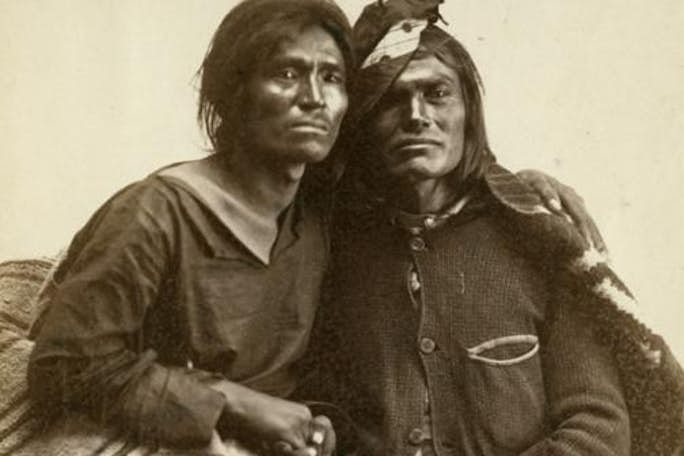Two Spirit and Non-Traditional Families
Author: Alex Vasquez, Lillian Guo
Subject: History
Topic: Integrated
Grade Levels: Elementary School: 4th Grade
Overview:
This lesson seeks to introduce students to different family models, specifically through comparing American and Native American culture. This lesson also seeks to define what it means to be Two Spirit and to discuss personal family narratives.
Time: 55 minutes
Lesson Plan Resources:
Lesson Objectives:
- Compare American and Native American family models.
- Explore how Two Spirit identities disrupt traditional definitions of the family.
- Discuss personal family narratives.
Essential Questions:
- How do American and Native American family models contrast?
- How might the various ways that Native Americans think about gender expression, identity, and culture provide additional family models that disrupt traditional definitions of what a family is?
Standards:
CCSS SL 4.1: Engage effectively in a range of collaborative discussions (one-on-one, in groups, and teacher-led) with diverse partners on grade 4 topics and texts, building on others’ ideas and expressing their own clearly.
HSS 4.2: Students describe the social, political, cultural, and economic life and interactions among people of California from the pre-Columbian societies to the Spanish mission and Mexican rancho periods.
HISTORY FRAMEWORK: CH 7 P 68: To bring California’s history, geography, diverse society, and economy to life for students and to promote respect and understanding, teachers emphasize its people in all their ethnic, racial, gender, and cultural diversity. Fourth-grade students learn about the daily lives, adventures, accomplishments, cultural traditions, and dynamic energy of the residents who formed the state and shaped its varied Grade Four landscape. There are multiple opportunities for students to learn what citizenship means by exploring the people and structures that define their state.
Vocabulary:
Two Spirit: A person of First Nations or Native American descent possessing both a male and female spirit.
Gender: How you feel – your own, personal sense of being a boy, girl, both, or neither.
Gender expression: The way someone expresses their gender identity, usually through appearance, dress, or behavior.
Gender identity: The gender that you feel you are – you can feel like a boy, a girl, both, or neither, and you can feel like a different gender than the one you were given at birth.
Race: A term used to identify and define individuals as part of a distinct group based on physical characteristics and some cultural and historical commonalities.
Sexuality: A term used to identify people based on who they are attracted to.
Teacher Background:
The teacher should be able to describe what gender expression and gender identity are. The teacher should have knowledge of what Two Spirit means and should be able to describe how Two-Spirit identity and gender influences family structures.
Materials:
- Paper
- Drawing supplies
Instructions:
Warm-up (10 minutes)
Watch an introductory video on Two-Spirit identity:
Have students share out what they learned from the video, what their first impressions are, and check to be certain that students understand the significance of Two-Spirit identity to Native American communities.
Begin a comparative discussion of American family models with Native American family models. While discussing, encourage students to consider through lenses of gender, sexuality, religion, and race. Use questions to guide the discussion, such as:
- What do you think a traditional family model looks like?
- How does gender influence traditional family roles?
- How might Two-Spirit identity impact the way a family looks?
- Would a Native American family look different than a traditional American family? Why?
- How do factors like race, gender, and sexuality shape the way a family can look?
- Why is it important to learn about different types of family models?
Group activity (25 minutes)
Create two separate groups. The first group will develop a storyboard depicting stereotypes of traditional American families. The second group will depict the characteristics of Native American culture that disrupt traditional family models. The storyboard can have as many panels as students want; they should try to build a story with a clear narrative. Give students 15 minutes to work on their storyboards.
After each group has completed their storyboard, have students present what they made. Allow time for students to share out their thoughts and ask questions about the other group’s storyboard.
While discussing both storyboards, the teacher should guide the conversation by encouraging students to compare and contrast the two types of family models. The teacher should also point out the various ways that Native American notions of gender expression, identity, and culture provide additional family models that disrupt traditional definitions of what a family is.
Conclusion (10 minutes)
Hand out a sheet of paper to each student. Every student should make a mini-storyboard to describe and share their own family background (such as having a single parent, same-sex parents, adopted and so on) in order to ground the lesson in a real, personal experience. Remind students that they are welcome to share as much or as little as they’d like on their storyboards.
Either as a large group or in pairs, have students share what they put on their storyboard, so students can learn about different types of family structures that exist in their own class. Encourage students to compare and contrast their own family structures to Native American and American family models.
Relevant Resources:
MacArthur, Alison – “Two Spirits in Native American Culture”
YouTube, 11 Apr. 2017 – www.youtube.com/watch?v=8vp389Y4M9o
Enos, Tony – “8 Things You Should Know About Two Spirit People”
Indian Country Today, 28 Mar. 2017 – newsmaven.io/indiancountrytoday/archive/8-things-you-should-know-about-two-spirit-people-294cNoIj-EGwJFOWEnbbZw/
Nagle, Rebecca – “The Healing History Of Two-Spirit, A Term That Gives LGBTQ Natives A Voice” TheHuffingtonPost.com, 30 June 2018 – www.huffingtonpost.com/entry/two-spirit-identity_us_5b37cfbce4b007aa2f809af1
Author Information:
Alex Vazquez works in HIV Care and Prevention at a clinic in Oakland. He is dedicated to intersectional movements within Public Health. He is based in Oakland, CA.
Lillian Guo is an undergrad student studying Learning Sciences at Northwestern University in Evanston, IL, and is a Summer 2018 Education intern at Our Family Coalition in San Francisco, CA.

